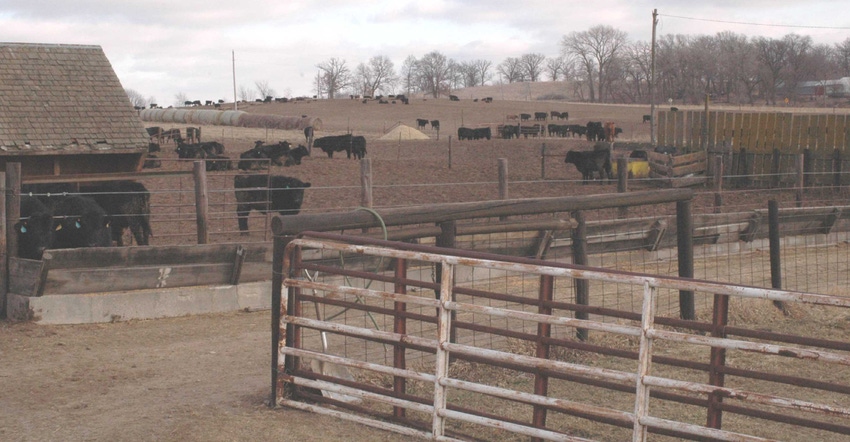Beef packing capacity rebound crucial
Livestock Outlook: Rising cattle supplies are continuing to face restricted packing capacity.
May 22, 2020

Temporary closures and slowdowns of packing plants due to the COVID-19 pandemic have created unprecedented product flow disruptions and price gyrations in the meat protein supply chain. Year-over-year declines in cattle slaughter progressively worsened through April. Weekly cattle slaughter dropped by 17% for the week ending April 11 to a decline of 35% for the week ending May 2.
Week-over-week slaughter increases in early May fueled guarded optimism that the worst of packing plant disruptions are over. Still, more than a month and counting with severely reduced slaughter means a backlog of slaughter cattle is growing rapidly.
Packers place utmost concern on worker health, safety and availability. They have engineered controls such as workstation alignments and modifications, plus worker physical distancing measures where possible. How much these adjustments will reduce packing plant capacity is a huge unknown. Arbitrary 10% to 15% figures have been suggested, but they’re just speculation. Only time will tell. Ingenuity will be a huge factor.
Capacity rebound crucial
Peak fed cattle slaughter typically occurs in summer. Slaughter rates will need to rise dramatically to work through the large supplies of cattle coming, including both on-time marketings and the backlog of overmarket-ready cattle that has developed.
Consumers need to know that no shortage of cattle available to produce beef exists. Rather COVID-19 presented a monumental challenge in converting cattle into beef. Temporary closures and slowdowns of meat packing plants, at a time when plants were running near capacity, caused a bottleneck in the cattle-beef supply chain and impacted beef packing plants’ ability to receive cattle and transform them into a wide array of beef and beef products.
Economics at work
Less beef temporarily being available means less meat available for retailers to buy, mostly grocery stores at this point. Limited restaurant traffic means meat consumption in the food-away-from-home sector remains sluggish. As a result, grocery stores and consumers are bidding up the price of available beef. Wholesale beef prices have surged, reaching a level never seen before, at least in nominal terms.
The wholesale-to-retail market is reacting rationally to market economy forces. A market economy is one in which buyers and sellers freely make decisions in response to supply and demand. Those decisions drive prices and production. In a market economy, prices measure availability or scarcity. Prices are reacting to a temporary tight meat supply from packers.
Implications for retail prices
Retail grocers plan sales many weeks in advance — to schedule advertising and ensure logistics of product supply. Beef takes many weeks to get from live animal to grocery store. Wholesale prices lead retail prices by many weeks. Different cuts can have different lag lengths. Some evidence suggests retailers react more quickly to rising wholesale prices than to falling wholesale prices.
Several factors contribute to the lag in retail price response. The time required to process, package, transport and shelve is one. Differences that exist in the assimilation of market information among both consumers and retail managers may also influence price response. The mix of procurement pricing strategies, i.e., negotiated vs. formula vs. forward contracted, may affect the price response between wholesale and retail.
Retailers' reluctance to change prices significantly in the short run is also a factor. Some retailers aren’t as compelled to match the prices of competing stores on beef as they are on other items. Weekly features of high-penetration, high-frequency staples such as meat and produce increases customer traffic and can give retailers an edge. Changing retail prices is costly in terms of time and materials, as well as customer goodwill. Altogether this suggests retail prices can be somewhat rigid relative to changes in wholesale prices.
While some major retail supermarket outlets have suspended or reduced retail ads because of temporarily lower beef supplies, sales are still finding their way to retail circulars. According to USDA’s National Retail Report, beef cuts from the chuck and round saw the most ad space May 15-21, while cuts from the loin, rib, brisket and ground beef saw less, although the flip was the case the previous week.
The collective feature rate of major retail supermarkets — the amount of sampled stores advertising any reported beef item during the current week expressed as a percentage of the total sample — was 65.8%, a 14.6 percentage point decline compared to the previous week. It was down about the same from a year ago. The special rate — the percentage of sampled stores with a no-price promotion, e.g., buy one, get one free, etc. — was 14.3%, and was about the same as the previous week but 24.9 percentage points lower than last year.
Outside factors to watch
Temporarily lower beef supplies should lead to higher beef prices but that presupposes a steady demand curve. Factors such as disposable income, unemployment levels and the overall economic environment will also play a role. The outlook for beef prices out front is precarious because the current dynamic greatly depends on processing capacity, purchasing patterns and, ultimately, consumer demand. Prices should begin to stabilize as those uncertainties ease.
A tendency exists to aggregate all cuts, qualities, sales types, destinations and delivery periods together as “beef.” But price impacts can differ significantly depending on which types are being considered. Just like cattle, all beef isn’t created equal. Several extrinsic and intrinsic characteristics differentiate cattle and beef. Those factors complicate price forecasting.
Since mid-March, the chuck, round and brisket components of the comprehensive cutout have surged the most. For the week ending May 15, the chuck, round and brisket were up 144%, 149% and 120%, respectively. In contrast, the rib, flank, short plate and loin were up 55%, 72%, 78% and 78%, respectively.
These changes make intuitive sense. Chuck and round prices are being driven higher by grocery demand for value cuts and ground beef. The rib and the loin are higher-priced beef cuts and haven’t benefited as much from the shift in meat buying from restaurants to groceries.
USDA’s Ag Marketing Service summarizes wholesale beef prices into a carcass equivalent value, known as the cutout value. It’s a single value derived from individual meat cut prices and is a rather broad measure with many assumptions, which USDA periodically adjusts by using industry input.
Daily, morning and afternoon, and weekly National Boxed Beef Cutout and Boxed Beef Cuts values are reported by USDA. These values are for negotiated or cash sales, with delivery within 21 calendar days and within the domestic market. Values are limited to USDA Choice and Select grades. Branded product is not included. All product is fresh except frozen 50% lean trimmings. Aged product is not included.
Weekly, on Monday for the prior week, USDA provides the National Comprehensive Boxed Beef Cutout report, which incorporates all sales methods. For the week ending May 15:
57% of sales were formula
35% were negotiated for delivery within 21 days
6% were negotiated for delivery in 22 days or more
2% were forward-contracted
This was similar to the purchasing volume reported in USDA’s National Weekly Fed Cattle Comprehensive report where for the week ending May 11:
59.46% of steer and heifer sales were formula
24.91% were negotiated
13.51% were forward-contracted
2.12% were negotiated grid
In terms of quality breakdowns, the weekly comprehensive report lists Prime (3% of the loads for week ending May 15), Branded (19%), Choice (30%), Select (12%), and Ungraded that includes cuts, grinds and trim (36%) categories. The weekly comprehensive cutout value is the most representative of all wholesale beef transactions.
The comprehensive cutout value bottomed for the year for the week ending March 13, then rebounded later in the month, then slipped in early to mid-April, and then surged into the week ending May 15. The overall comprehensive cutout value for the week ending May 15 was $421.80 per cwt, up 94% from the same week a year ago. For reference, the weekly negotiated Choice cutout was $459.04 per cwt, up 108% from the same week a year ago.
Schulz is the ISU Extension livestock marketing economist. Email [email protected].
About the Author(s)
You May Also Like




.png?width=300&auto=webp&quality=80&disable=upscale)
